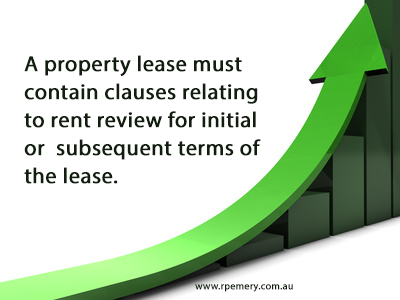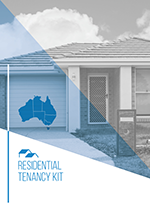Rent review clauses give the landlord the right to increase the rent at specific, stated intervals. The intention to increase rent during the term or any further terms of a Lease, must be stated within the Lease Agreement.
It is important that the terms of your Lease are clear and easily understood – and this is especially so in the case of rent review clauses.

When including a rent review clause in your Lease, it is essential to specify:
- the amount of the increase (or a formula setting out how the amount can be calculated), and
- when the rent review or reviews will take place.
You should also consider including a provision requiring the tenant to top up the bond amount in line with the increased rent.
Methods of rent adjustment
There are a few standard methods of rent adjustment, and they are:-
Rent increase by a fixed amount
Often landlords specify a fixed amount to increase the rent at certain specified intervals. You must identify within the Lease the dates on which the rent will be increased, and the amount it will be increased by.
For example: The rent will increase by $[specified amount], on each anniversary of the Commencement Date.
Rent increase by a fixed percentage
You may specify a specific percentage to be applied to the rent at certain intervals.
For example: The rent will increase by [specified percentage]% on [specify date or dates].
Increasing the rent by CPI
The CPI (or consumer price index)measures the rise or fall in in prices of goods and services, and is published every quarter by the Australian Bureau of Statistics.
CPI is broken down into various commodity groups (for example “housing”, “transport”, etc), as well as an “all groups” average for each capital city, as well as being expressed as a national figure.
- You can access the latest CPI figures from the ABS here.
- The Capital Cities Data for the current quarter is here.
Care should be taken when incorporating a CPI adjustment mechanism within your Lease. You will need to specify, among other things, the CPI index you wish to apply, for example, All Groups Melbourne, the frequency of the adjustment, and the formula to be used to apply the adjustment.
Our state based Commercial Leases use the formula for CPI based on Capital City All Group.
The Australian Bureau of Statistics provides further information here.
Avoid “Ratchet Clauses”
Be aware that some jurisdictions prevent you from using specifically worded clauses (termed ratchet clauses) to avoid a rent adjustment where the CPI has decreased rather than increased. In such cases, the decrease in CPI must be applied.
Notifying the tenant of the increase
Depending on the nature of your Lease and the legislation that may apply (whether residential, retail or commercial), you may be required to give formal written notice to the tenant before the increase takes effect. In any case, it makes good business sense to notify your tenant well in advance of the increase in the rent.
 Be sure to diarise all rent review dates and have systems in place to give you adequate time to calculate and notify the tenant of the new rent before the changes takes effect.
Be sure to diarise all rent review dates and have systems in place to give you adequate time to calculate and notify the tenant of the new rent before the changes takes effect.
Further resources:
More information and comprehensive Lease Agreements with instructional User’s Guides, can be found here:
Lease Agreement Template Kits for Each Australian State
 This easy-to-use template kit contains everything you need to successfully lease your commercial premises. It contains the Lease Agreement Template, Easy-to-follow Users Guide and Agreement to Lease
This easy-to-use template kit contains everything you need to successfully lease your commercial premises. It contains the Lease Agreement Template, Easy-to-follow Users Guide and Agreement to Lease
Retail Lease kit
- Professionally drafted retail lease Agreement (doc)
- Professionally Drafted Disclosure statement
- Sample disclosure statement and Retail lease
- Easy to follow help guide
- Getting Started document
- Friendly customer support
 Residential Tenancy Lease Agreement Kit
Residential Tenancy Lease Agreement Kit
Property management fees can really eat into your return. By choosing to manage the property yourself you can maximise your ROI and eliminate another unnecessary cost.
Our easy-to-use residential tenancy kit includes all the documents you need to set up and manage your tenancy.


